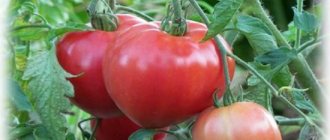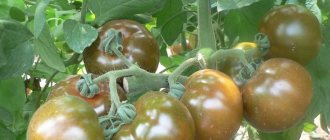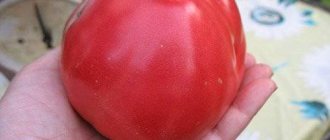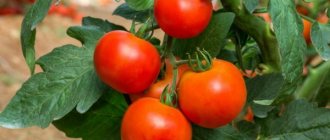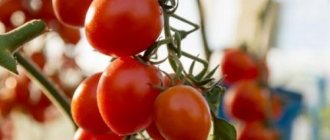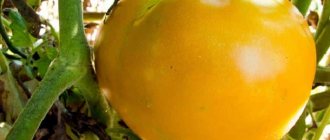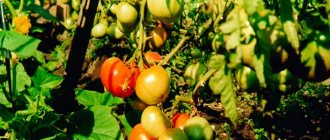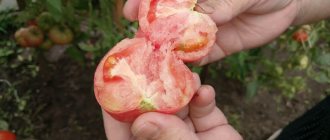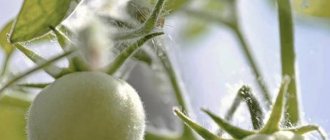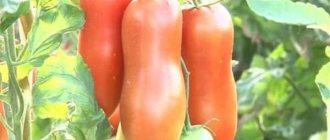Characteristics of tomato Altai honey
Tomato plants of the Altai honey variety grow up to 1.5 m in open ground. In greenhouses, the determinate tomato grows higher. The leaves are of the usual type, long, medium in size, not dense. For good development, tall, large-fruited tomatoes are tied up. Mandatory care includes stepsoning. Gardeners recommend growing plants of a productive variety with two stems. Intermediate inflorescences are formed on plants. Each cluster bears 5-6 fruits, even and identical, with an average weight of 250-400 g.
Many people like the warm, bright orange color of the skin and pulp of Altai honey tomatoes. A spot near the stalk of a rich green color, which stands out on unripe tomatoes, is not visible on ripe ones. The color is apricot-yellow, uniform. The fruits are rounded at the stalk, heart-shaped, slightly ribbed. The skin is smooth, dense, and does not crack. The juicy pulp is fleshy, of medium density, with 4-6 large seed chambers. Altai honey tomatoes, according to descriptions and reviews, contain few seeds.
According to its characteristics, the Altai salad honey variety is ideal for fresh consumption. Excess fruit is suitable for processing for the winter: raw material for assorted salads, juices, pastes, purees. The plant is classified as an early ripening plant; tomatoes are harvested 90-105 days after the sprouts appear. If the seeds for seedlings were sown in February, the first harvest is harvested in July.
Characteristics of the variety
Honey Heart is a first generation hybrid variety. The plant grows to a small height - no more than 70 centimeters, and sometimes less. The variety is early ripening. The first harvest can be harvested 90-95 days after the seedlings sprout.
The hybrid variety is characterized by high yield. From one square meter you can harvest about 8-8.5 kilograms of tomatoes. In the southern regions, the determinate type plant is successfully grown in open beds; in places with a temperate climate, cultivation in greenhouse conditions or in containers is recommended. Bushes should be formed into one stem.
The plant produces small, round fruits shaped like a heart. Tomatoes have smooth, non-pointed ends. The color of the skin and pulp of ripe tomatoes can range from pale yellow to a more intense orange-yellow. The weight of one fruit ranges from 120 to 140 grams.
The pulp of Honey Heart tomatoes contains many useful substances, which will appeal to those who adhere to proper nutrition or are on a diet. During the summer months, yellow tomatoes will be the main supplier of beta-carotene. In addition, the pulp of such fruits contains a large amount of sugars. Children love them very much for their sweet taste and bright color.
Tomatoes can be picked from the bush while they are not yet ripe - the fruits ripen well at home, accumulating the required amount of sugars. Honey Heart tomatoes have a fairly long shelf life; they are consumed fresh and used to prepare healthy tomato juice.
tomato Lazy Dream - description and characteristics of the variety
Pros and cons of the Altai honey tomato variety
According to the characteristics and description of the variety, the Altai honey tomato has many advantages in cultivation:
- excellent taste properties;
- large-fruited;
- not prone to skin cracking;
- productive;
- spectacular appearance of the fruit;
- transportable;
- early ripening;
- disease resistant.
Among the disadvantages of Altai honey tomatoes, which are recommended to be grown in the middle zone in greenhouses, are:
- the need to form a bush for the appropriate harvest;
- mandatory installation of supports or trellises for tall varieties;
- carrying out regular fertilizing;
- in open ground in some areas tomatoes do not have time to ripen.
Prevention and control of diseases
Despite the high resistance characteristics of the variety, Honey Giant tomatoes require preventive measures: correct crop rotation will help to avoid late blight and other fungal diseases.
The basic rule: beds for tomatoes cannot be laid out on the site of nightshades and in the vicinity of potato plots.
Universal preventive measures include: regular ventilation, loosening, weeding, mulching, timely fertilizing, removing the lower leaves from the bush.
Preventive spraying (Bordeaux mixture, calcium nitrate, kefir, garlic infusion, copper sulfate) helps against rot and other fungal diseases.
Insect pests need to be washed off the leaves with a soap solution and sprayed with biological products or insecticides.
HONEY GIANT TOMATOTomato Honey Giant. AelitaThe most delicious yellow-fruited tomatoes.
Growing
The yield of Altai honey tomatoes, according to reviews and photos, is achieved by complying with the requirements of agricultural technology when planting and caring for tall plants.
Growing seedlings
In order to get a harvest of orange tomatoes in mid-summer, you need to sow the seeds from late February or early March. For the initial phase of seedlings prepare:
- plastic, ceramic or wooden containers with holes at the bottom;
- purchased universal soil or a self-prepared substrate of peat and sand in equal parts;
- phytolamps for additional illumination of sprouts in cloudy weather.
The seeds are deepened into the soil by 0.5-1 cm. The container is covered with glass or plastic film and placed near the battery so that the temperature in the container does not drop below 20 °C. Tomatoes germinate in 6-7 days. Having seen the first shoots, the shelter is removed from the container and transferred to a cooler but brighter place. With a temperature of 18 °C and sufficient lighting, at least 12 hours per day, the seedlings become strong within a week. Then the temperature is gradually increased to a comfortable level for tomatoes of 23-25 °C.
When the first or second true leaf appears on the sprouts, they are picked: transplanted into separate cups. The tomatoes will grow in the container until they are planted in a permanent place in a greenhouse or garden. When growing seedlings, check the condition of the soil every day. The substrate should be moderately moist; the soil should not be allowed to dry out.
Important! During seedling development, special attention is paid to maintaining moderate soil moisture, comfortable air temperature and bright lighting.
Landing rules
Tomato seedlings are moved to a permanent place after 55-60 days of development. At this point, the plants are 25-30 cm high, with 8-9 leaves formed and the first fruit raceme being formed. It is recommended to plant no more than 3 Altai honey tomato plants per 1 square meter, both in a greenhouse and in open ground. Supports are immediately installed: strong pegs, 1.2-1.5 m high, or trellises are constructed. In the garden, the support is installed at least 10 cm from the stem.
When landing, adhere to the following requirements:
- dig spacious planting holes so that the root system of tomatoes can freely fit in them along with a lump of earth;
- pour up to 1 liter of water into the wells;
- the seedling is placed in the hole when the water is completely absorbed;
- compact the soil around the root and sprinkle it with soil to the level of the garden.
Attention! You can add 1 tablespoon of ammonium nitrate to the hole for strength and powerful growth of seedlings.
Watering and fertilizing
Water the tomato seedlings after a few days. In the garden they are guided by the weather - in 3 or 5 days. The bushes are watered in the evening with warm water that has settled during the day. Pour at least 1 liter of water under each tomato. Tomatoes need sufficient moisture during the period of bud formation, flowering and fruit production.
Altai honey tomatoes are fertilized with mineral and organic substances. The first fertilizing is applied 2 weeks after planting the tomatoes. The mullein solution is diluted with water in a ratio of 1:5. The following feedings are also carried out at intervals of 14-17 days. Various complex mineral fertilizers are used:
- "Fertika";
- "Crystalon";
- nitrophoska or nitroammofoska and others.
Advice! Supporting tomato yields by foliar fertilizing with boric acid is popular for its effectiveness.
Pinching and tying
Tall Altai honey bushes need stem staking. The shoots are tied with light material that will not injure the delicate tissues of the plant. In addition to the stems, fruit clusters are also tied up, because they are usually heavily loaded with harvest. Good development of a tomato plant is impossible without pinching. The shoots in the leaf axils are removed systematically. Stepchildren are not allowed to grow more than 7-8 cm. When breaking off, a stump 1 cm long is left to stop the creation of a new shoot.
Formation
The productivity of tall, large-fruited tomatoes Altai honey of Siberian selection depends on the competent formation of plants. From the beginning of the development of the bush, choose a strong first or second stepson from the bottom and lead it with a separate stem. Gardeners claim that the best results are obtained from those bushes that are formed into two stems. When 4-5 clusters are created on both shoots, pinch off the tops of the stems. This procedure helps the plant direct energy to fill and ripen the already formed fruits. In open ground conditions, it is advisable to do pinching after 3-4 fruit clusters, so that the tomatoes have time to ripen during the hot season.
Protection from diseases and pests
The variety is resistant to fungal diseases, and to prevent them:
- the greenhouse is regularly ventilated;
- remove the lower wilted leaves;
- tomatoes are planted in a timely manner.
Whiteflies and aphids are fought with folk or chemical means.
Characteristics of the variety
Plant of indeterminate type. The bushes grow up to 1.5 m and require obligatory gartering to a trellis or to a support in the form of a stake.
It is recommended to form a bush with 1 or 2 stems and regularly remove stepsons.
In terms of ripening time, Honey Giant belongs to the group of mid-early tomatoes. The fruits begin to ripen 100-110 days after germination. The variety is promising against infections, is rarely exposed to diseases and does not require treatment with chemicals.
To produce fruits of the stated size, the variety needs fertilizers. These can be either complex fertilizers for tomatoes or mineral ones containing nitrogen, potassium, phosphorus and other microelements necessary for the full development of plants.
Large and tasty fruits are used for making salads and salted for the winter. Due to their large size, canned food is not made from them. They also do not practice the production of juice and tomato paste.
Productivity
The yield indicator is one of the most important characteristics of a variety. Using it, vegetable growers determine whether they need this variety and how many bushes should be planted to provide their family with fresh tomatoes.
The yield of one Honey Giant plant is 4-5 kg. From 1 m² you can expect a tomato yield of 15 kg if you adhere to the standard planting scheme of 3 plants per 1 m².
